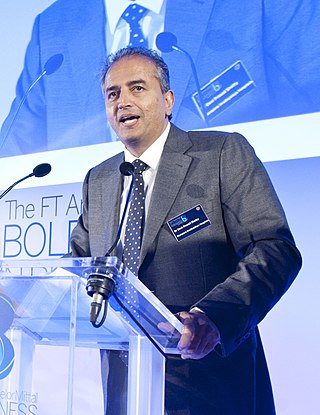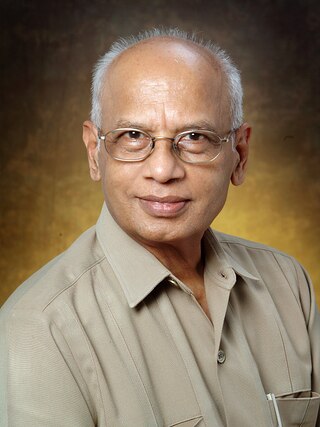
Devi Prasad Shetty is an Indian cardiac surgeon who is the chairman and founder of Narayana Health, a chain of 24 medical centers in India. He has performed more than 100,000 heart operations. In 2004 he was awarded the Padma Shri, the fourth highest civilian award, followed by the Padma Bhushan in 2012, the third highest civilian award by the Government of India for his contribution to the field of affordable healthcare.

Kotturathu Mammen Cherian, is an Indian heart surgeon. He performed India's first coronary artery bypass surgery and first heart Lung transplant. and is considered a pioneer of pediatric cardiac surgery in the country. He is also a former honorary surgeon to the President of India and a Padma Shri awardee.

Marthanda Varma Sankaran Valiathan was an Indian cardiac surgeon. He was a president of the Indian National Science Academy and a National Research Professor of the Government of India.

Naresh Trehan is an Indian cardiovascular and cardiothoracic surgeon. After graduating from King George's Medical University, Lucknow, India, he went on to practice at New York University Medical Center, Manhattan, USA from 1971 to 1988. He returned to India and started Escorts Heart Institute and Research Centre. He serves as the chairman and managing director and chief cardiac surgeon of Medanta-The Medicity. He has served as personal surgeon to the President of India since 1991, has received numerous awards, including the Padma Shri, Padma Bhushan, Lal Bahadur Shastri National Award and Dr. B. C. Roy Award.

Mahendra Bhandari is an Indian surgeon who has made substantial contributions to the specialty of urology, medical training, hospital administration, robotic surgery and medical ethics. For his efforts, he was awarded the Padma Shri by the government of India in 2000. Bhandari is currently Senior Bio-scientist and Director of Robotic Surgery Research & Education at the Vattikuti Urology Institute (VUI) in Detroit, MI. He was the Symposium coordinator of the International Robotic Urology Symposium. He also has been the CEO of the Vattikuti Foundation since 2010.
R.V.S. Yadav was born on 27 July 1937 in Nauliharnathpur, Uttar Pradesh, India. He was awarded the MBBS in 1961 and the MS (Surgery) in 1964 respectively from the King George's Medical College, Lucknow University, Lucknow. He received the FICS in 1974 from the International College of Surgeons and the FACS in 1977 from the American College of Surgeons.

Jai Pal Singh was an Indian physician, surgeon, and educator. He made contributions to medical science and education in India, particularly in the fields of surgery and medical administration. He was honoured with the Hari Om Ashram Prerit Award in 1986 and the Padma Shri award presented by the President of India in 1991.

Global Health Limited, d/b/a Medanta, is an Indian for-profit private hospital network based in Gurgaon. The chain was started in 2009 by cardiac surgeon Naresh Trehan and Sunil Sachdeva.

Subhash Gupta is an Indian hepatobiliary-pancreatic surgeon and the chairman of the Max Center of Liver and Biliary Science at Max Healthcare, Saket.
Ashok Rajgopal is an Indian orthopaedic surgeon, credited with close to 20,000 Arthroscopic and over 35,000 Total Knee Arthroplasty surgeries and reported to be one of the most experienced in his field in India. He was honoured by the Government of India in 2014, by bestowing on him the Padmashri, the fourth highest civilian award, for his services to the fields of orthopaedic surgery. He has also been awarded the Dr. BC Roy award by the Medical Council of India to "Recognize the Best Talents in Encouraging the Development of Specialties in Different Branches in Medicine" for 2014.
Jeewan Singh Titiyal is an Indian ophthalmologist, credited with the first live cornea transplant surgery by an Indian doctor. He was honoured by the Government of India, in 2014, by bestowing on him the Padma Shri, the fourth highest civilian award, for his services to the field of medicine.

K. P. Haridas is an Indian surgeon specializing in minimally invasive surgeries, and the founder of Chairman of Lords Hospital, a super-specialty healthcare centre in Thiruvananthapuram. He is credited with the first successful liver resection, which he performed at the Government Medical College, Thiruvananthapuram.

Dr Hargovind Laxmishanker "H. L." Trivedi was an Indian nephrologist, immunologist, transplant surgeon and stem cell researcher.
OSMECON is an undergraduate medical conference hosted annually by Osmania Medical College and its associated hospitals in Hyderabad, India.
Samiran Nundy is an Indian gastrointestinal surgeon, medical academic, writer and the President of All India Institute of Medical Sciences, Rishikesh. He is a former member of the faculty at the Cambridge University, London University and Harvard University, and is the founder editor of the National Medical Journal of India and Tropical Gastroenterology. The Government of India awarded him the fourth-highest Indian civilian honour of Padma Shri in 1985.

Daljit Singh was an Indian ophthalmologist. He was an honorary surgeon to Giani Zail Singh, President of India.
Narmada Prasad Gupta is an Indian urologist, medical researcher, writer and the chairman of Academics and Research Division Urology at the Medanta, the Medicity, New Delhi. He is credited with over 10,000 urological surgical procedures and the highest number of urology robotics (URobotic) surgeries in India. He is a former head of the department of urology of the All India Institute of Medical Sciences Delhi and a former president of the Urological Society of India. He received the Dr. B. C. Roy Award, the highest Indian award in the medical category, from the Medical Council of India in 2005. The government of India awarded him the fourth highest civilian honour of the Padma Shri, in 2007, for his contributions to Indian medicine.
Ashok K. Vaid is an Indian medical oncologist, who specializes in bone marrow transplantation. He is credited with the performance of the first 25 bone marrow transplantations in the private sector in North India. He heads the Cancer Institute- Division of Medical Oncology and Haemotology at Medanta The Medicity.
Shiv Kumar Sarin is an Indian physician; a hepatologist and, gastroenterologist. Under of Delhi Government, he set up the Institute of Liver and Biliary Sciences (ILBS); the largest liver hospital and a deemed Liver University, and a WHO Centre. He has received Shanti Swarup Bhatnagar Prize, The World Academy of Science Prize, and Padma Bhushan in 2007. He served as Chairman Board of Governors of Medical Council of India and shaped the New Medical Education Vision, including NEET and NEXT exams. He is a leader in science and served as the President of the Asian Pacific Association for study of Liver and is currently the President of the National Academy of Medical Sciences (NAMS) of India (2021-2024).
Chitranjan Singh Ranawat is an American orthopedic surgeon of Indian origin.











